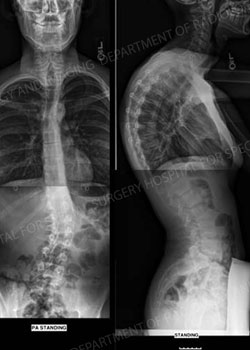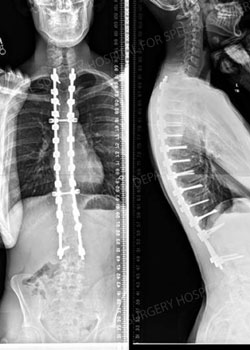Kyphosis in the Pediatric Patient
An interview with HSS surgeons John S. Blanco, MD and Roger F. Widmann, MD
Good posture and healthy spine development is a universal concern among parents. Children whose curvature exceeds a limited range of variation - curving forward in a “C” shape- will require medical attention and may be diagnosed with kyphosis. Together with scoliosis, another type of curvature, this condition comprises a significant proportion of spinal deformity diagnoses seen by pediatric orthopedists.
Diagnosing Kyphosis
The origin of the Kyphosis can be idiopathic (of unknown origin), congenital (present at birth) or neuromuscular (related to the nerves and muscles). Abnormal development of the spinal column in the womb characterizes congenital kyphosis. The vertebrae may be formed abnormally or may be fused together. Surgical intervention is frequently required in order to prevent progressive deformity as well as to prevent injury to the spinal cord.
Kyphosis is diagnosed in children with a forward curve of greater than 45 degrees.
Children with kyphosis who are able to straighten up to normal posture are considered to have flexible round back deformity. In such cases the pediatric orthopedist may recommend physical therapy to strengthen the back muscles. “Many of these children respond well and do not need additional therapy,” says John S. Blanco, MD Associate Attending Orthopedic Surgery at Hospital for Special Surgery (HSS).
In cases where the x-ray shows specific vertebral body changes, the child may be diagnosed with Scheuermann’s kyphosis. This condition usually appears in adolescence. Scheuermann’s kyphosis is marked by the presence of vertebral wedging in three or more vertebrae in a row, which can be seen on a lateral (side-view) x-ray.
Figures 1 & 2:
16-year-old male who presented with Scheuermann kyphosis

click image to enlarge
Figure 1. Pre-Operative x-ray images demonstrating a 80° thoracic kyphosis and a 22° thoraco-lumbar scoliosis.
Treating Kyphosis
In a growing child, treatment of Scheuermann’s kyphosis with a spine brace may be effective. However, if the deformity continues to progress—reaching 70 degrees or greater—and the child has finished growing, surgical intervention is an option. In such cases, instrumentation is used to bring the spine into alignment, and bone grafts are made to maintain the correction of the spine.
According to Roger Widmann, MD, Chief of Pediatric Orthopedic Surgery at HSS, “Rarely, with very large, stiff kyphosis, anterior (front) spinal release and fusion surgery is required in addition to posterior (rear) spinal fusion and instrumentation in order to achieve satisfactory alignment and fusion of the spine.” Left untreated, Scheurmann’s kyphosis may result in progressive deformity, back pain, and, very infrequently, neurological problems.

click image to enlarge
Figure 2. Post operative x-ray images demonstrating the surgical correction that was achieved.
If you would like more information about the Scoliosis Service at HSS, please visit the Physician Referral Service or call 1.877.606.1555.
Summary by Nancy Novick
Authors
Attending Orthopedic Surgeon, Hospital for Special Surgery
Associate Professor of Clinical Orthopedic Surgery, Weill Cornell Medical College
Attending Orthopedic Surgeon, Hospital for Special Surgery
Professor of Clinical Orthopedic Surgery, Weill Cornell Medical College



